
The Merchants Avenue Historic District in a residential neighborhood southeast of the downtown in Fort Atkinson, Wisconsin, composed of 33 mostly large homes on large lots within six city blocks around Merchants Avenue. It was placed on the United States National Register of Historic Places in 1986.

The Prospect Hill Historic District encompasses a large residential area in the Willimantic section of Windham, Connecticut. Located north of the Main Street commercial district, it was developed between about 1865 and 1930, and is one of the state's largest historic districts, with more than 800 contributing buildings. It is roughly bounded by Valley, Jackson, Bolivia, Washburn, Windham, and High Streets, and contains one of the state's largest single concentrations of Victorian-era residential architecture. It was listed on the National Register of Historic Places in 2003.
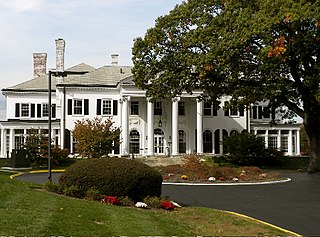
The Prospect Hill Historic District is an irregularly-shaped 185-acre (75 ha) historic district in New Haven, Connecticut. The district encompasses most of the residential portion of the Prospect Hill neighborhood.

The West End South Historic District encompasses a neighborhood of mid 19th to early 20th century residential architecture in western Hartford, Connecticut and eastern West Hartford, Connecticut. Roughly bounded by Prospect and South Whitney Streets, West Boulevard, and Farmington Avenue, the area includes a large number of Colonial Revival and Queen Anne houses, as well as numerous buildings in other period styles, with only a small number of losses. It was listed on the National Register of Historic Places in 1985.
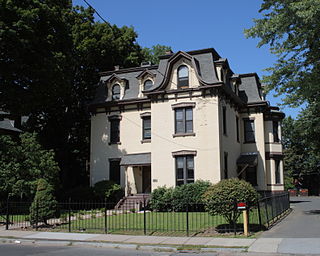
136-138 Collins Street is an architecturally distinguished Second Empire house in Hartford. Built about 1870, it is a rare and well-preserved example of this style in the city. It was listed on the National Register of Historic Places on April 29, 1982.

142 Collins Street is an architecturally distinguished Queen Anne Victorian house in Hartford, Connecticut. Built about 1890, it is typical of houses that were once much more common the city's Asylum Hill neighborhood. It was listed on the National Register of Historic Places on November 29, 1979.

83-85 Sigourney Street in Hartford, Connecticut was an Italianate style double brick house. Built in 1865, it was the oldest surviving residential building on the southern part of Sigourney Street in the city's Asylum Hill neighborhood. It was listed on the National Register of Historic Places in 1979, at a time when there were no known threats to the building. A modern building, housing the former Connecticut Culinary Institute, was built on the site in 1981 and now stands at 85 Sigourney Street; it is the Hartford campus of the Lincoln Culinary Institute, and is part of the Lincoln Group of Schools.
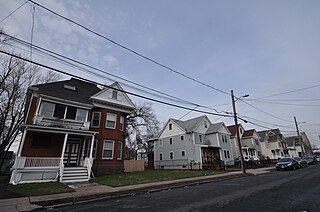
The Allen Place–Lincoln Street Historic District encompasses a small neighborhood of late 19th-century housing built for white-collar service workers in southern Hartford, Connecticut. It is roughly bounded by Madison, Washington, and Vernon Streets, and Zion Hill Cemetery, and has well-preserved examples of vernacular Queen Anne and Colonial Revival architecture. It was listed on the National Register of Historic Places in 2003.
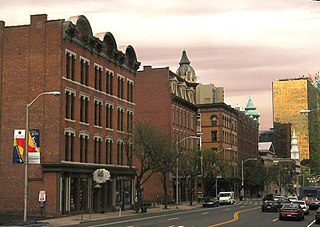
The Buckingham Square District of Hartford, Connecticut encompasses a mixed residential and commercial neighborhood area just south of the city's downtown. It is centered around Buckingham Square, laid out in 1830 on the site of an early colonial-era church. The district includes a concentration of well-preserved Victorian architecture from the 1860s to 1890s. It was listed on the National Register of Historic Places in 1977, and slightly enlarged in 1982.

The Capen-Clark Historic District encompasses a residential neighborhood area in the North End of Hartford, Connecticut. Centered on Capen Street between Main and Enfield Streets, it contains a cross-section of post-Civil War Victorian vernacular housing styles, and shows in its development patterns the ebb and flow of the city's economy between about 1865 and 1910. The district was listed on the National Register of Historic Places in 1982.

Charter Oak Place is a street on the south side of downtown Hartford, Connecticut. Laid out in the 1860s, its residential character is in marked contrast to the commercial development that predominates around it. The street's buildings, constructed between the early 1860s and 1900, are a cross-section of Victorian architectural styles. The entire length of the street is listed on the National Register of Historic Places.

The Central Avenue-Center Cemetery Historic District encompasses part of the town center of East Hartford, Connecticut. Although it was founded in the mid-17th century, it is now dominated by architecture of the late 19th and early 20th centuries. The Center Cemetery is the town's oldest surviving property, and includes the grave of William Pitkin, a colonial governor. The district, including portions of Main Street and Central Avenue, was listed on the National Register of Historic Places in 1993.

The Calvin Day House is a historic house at 105 Spring Street in Hartford, Connecticut. Built in 1852, it is the last survivor of a series of fine Italianate houses that lined a bluff overlooking Hartford's Union Station. It was listed on the National Register of Historic Places in 1978. It now houses a social service agency.

The Imlay and Laurel Streets District is a residential historic district on portions of Imlay, Laurel, Hawthorn and Sigourney Streets in Hartford, Connecticut. The area is a densely built residential neighborhood developed between about 1870 and 1895, with predominantly brick Italianate and Queen Anne construction. The district was listed on the National Register of Historic Places in 1979.

The Jefferson-Seymour District is a historic district encompassing a residential area on the south side of Hartford, Connecticut. Covering portions of Cedar, Wadsworth, Seymour and Jefferson Streets, it contains a well-preserved collection of late 19th and early 20th-century middle-class residential architecture, primarily executed in brick. It was listed on the National Register of Historic Places in 1979.

The Laurel and Marshall Streets District is a historic district encompassing a late-19th and early-20th century residential area in the Asylum Hill neighborhood of Hartford, Connecticut. Extending along Laurel and Marshall Streets between Niles and Case Streets, its housing stock represents a significant concentration of middle-class Queen Anne architecture in the city. It was listed on the National Register of Historic Places in 1979.
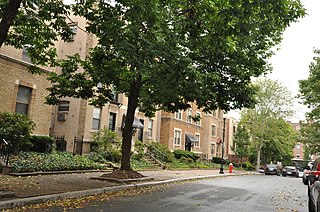
The Little Hollywood Historic District encompasses a concentrated collection of apartment buildings built mainly between the world wars in the Asylum Hill neighborhood of Hartford, Connecticut. Located on Farmington Avenue and Owen, Frederick, and Denison Streets, they were built primarily to attract single tenants seeking small apartments, a trend that developed after World War I and ended after World War II. The district was listed on the National Register of Historic Places in 1982.

The Signourney Square Historic District encompasses a neighborhood in the Asylum Hill area of Hartford, Connecticut, that was almost entirely built out in a single decade at the end of the 19th century as a middle-class residential area. It is roughly bounded by Garden, Ashley, and Woodland Streets on the east, south, and west, and by railroad tracks north of Sargeant Street to the north. The area retains much of its late 19th-century character, with relatively few modern intrusions. It was listed on the National Register of Historic Places in 1979, with small additions in 1983 and 2011.

The Spencer House is a historic house at 1039 Asylum Avenue in Hartford, Connecticut. Built in 1929 for a bank chairman, it is one of the last grand houses to be built in the city's Asylum Hill area, and is a good example of Georgian Revival architecture. It was listed on the National Register of Historic Places in 1983.

The Walnut Street Historic District is a nationally recognized historic district located in Waterloo, Iowa, United States. It was listed on the National Register of Historic Places (NRHP) in 2019. At the time of its nomination the district consisted of 111 resources, including 91 contributing buildings and 20 non-contributing buildings. The district is largely a residential area located between the central business district and the former location of the Illinois Central Railroad round house and shops. The neighborhood was originally platted as the Railroad Addition in 1860 and as the Cooley Addition in 1865. Buildings date from c. 1880 to 1981. Single-family houses are largely wood-frame construction with a few brick. Architectural styles include Queen Anne, Italianate, Shingle, Bungalow, variations on the American Foursquare, and those in a vernacular mode. Multi-family dwellings include double houses, identical houses, and apartment buildings. There are also a few commercial buildings on East Fourth Street and two churches. Walnut Street Baptist Church (1908) is individually listed on the NRHP. Two local architects, Mortimer Cleveland and Clinton Shockley have buildings in the district.






















